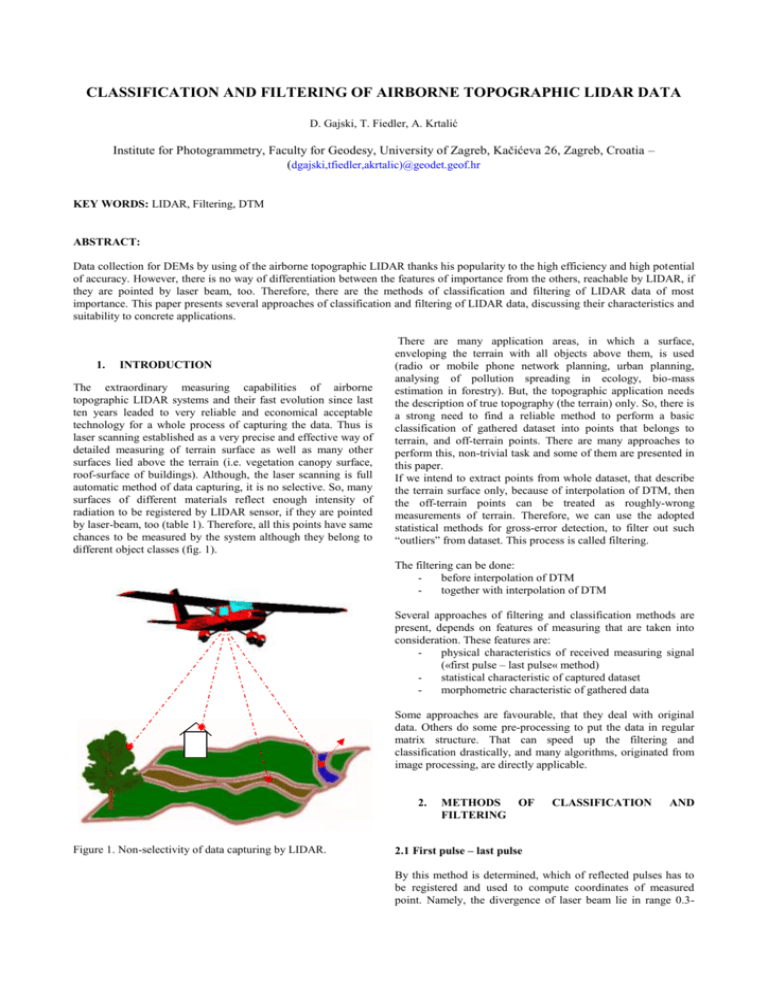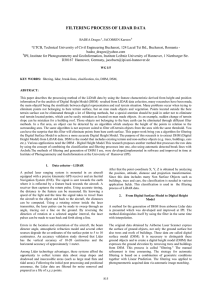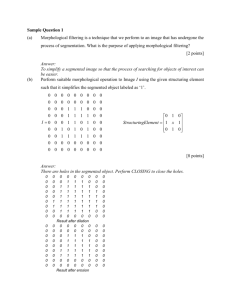classification and filtering of airborne topographic LIDAR data
advertisement

CLASSIFICATION AND FILTERING OF AIRBORNE TOPOGRAPHIC LIDAR DATA D. Gajski, T. Fiedler, A. Krtalić Institute for Photogrammetry, Faculty for Geodesy, University of Zagreb, Kačićeva 26, Zagreb, Croatia – (dgajski,tfiedler,akrtalic)@geodet.geof.hr KEY WORDS: LIDAR, Filtering, DTM ABSTRACT: Data collection for DEMs by using of the airborne topographic LIDAR thanks his popularity to the high efficiency and high potential of accuracy. However, there is no way of differentiation between the features of importance from the others, reachable by LIDAR, if they are pointed by laser beam, too. Therefore, there are the methods of classification and filtering of LIDAR data of most importance. This paper presents several approaches of classification and filtering of LIDAR data, discussing their characteristics and suitability to concrete applications. 1. INTRODUCTION The extraordinary measuring capabilities of airborne topographic LIDAR systems and their fast evolution since last ten years leaded to very reliable and economical acceptable technology for a whole process of capturing the data. Thus is laser scanning established as a very precise and effective way of detailed measuring of terrain surface as well as many other surfaces lied above the terrain (i.e. vegetation canopy surface, roof-surface of buildings). Although, the laser scanning is full automatic method of data capturing, it is no selective. So, many surfaces of different materials reflect enough intensity of radiation to be registered by LIDAR sensor, if they are pointed by laser-beam, too (table 1). Therefore, all this points have same chances to be measured by the system although they belong to different object classes (fig. 1). There are many application areas, in which a surface, enveloping the terrain with all objects above them, is used (radio or mobile phone network planning, urban planning, analysing of pollution spreading in ecology, bio-mass estimation in forestry). But, the topographic application needs the description of true topography (the terrain) only. So, there is a strong need to find a reliable method to perform a basic classification of gathered dataset into points that belongs to terrain, and off-terrain points. There are many approaches to perform this, non-trivial task and some of them are presented in this paper. If we intend to extract points from whole dataset, that describe the terrain surface only, because of interpolation of DTM, then the off-terrain points can be treated as roughly-wrong measurements of terrain. Therefore, we can use the adopted statistical methods for gross-error detection, to filter out such “outliers” from dataset. This process is called filtering. The filtering can be done: before interpolation of DTM together with interpolation of DTM Several approaches of filtering and classification methods are present, depends on features of measuring that are taken into consideration. These features are: physical characteristics of received measuring signal («first pulse – last pulse« method) statistical characteristic of captured dataset morphometric characteristic of gathered data Some approaches are favourable, that they deal with original data. Others do some pre-processing to put the data in regular matrix structure. That can speed up the filtering and classification drastically, and many algorithms, originated from image processing, are directly applicable. 2. Figure 1. Non-selectivity of data capturing by LIDAR. METHODS FILTERING OF CLASSIFICATION AND 2.1 First pulse – last pulse By this method is determined, which of reflected pulses has to be registered and used to compute coordinates of measured point. Namely, the divergence of laser beam lie in range 0.3- 2mrad typically (Baltsavias, 1999) what at the relative flying height of 1000m above ground results with a laser footprint of 0.3 – 2 m in diameter. The object smaller of this footprint reflects a portion of laser radiance, but cannot shield other objects underneath it to be illuminated by laser beam, so they reflect laser radiance, too. Finally, the rest of laser radiance reaches the ground surface. So, we have multiple returns for one emitted laser pulse, depending on structure of illuminated object (fig. 2). 1ST return 2ND return 3rd return last return importance for forest inventory applications (Peterson et al. 2001). 2.2 Iterative robust interpolation with linear prediction The discrepancies between off-terrain points, gathered by laser scanning, and real terrain surface can be divided into two parts. The first one consists of discrepancies induced by random errors only. They are relatively small in absolute amount, and normally distributed. Therefore, their impact on interpolated DTM can be minimised by using linear prediction as an interpolation method. The second one consists of discrepancies that originated from wrong classification of non-ground points. These discrepancies have almost the positive sign only, because they are induced by misclassified points belonging to objects above terrain surface. Their absolute value is relatively big and they should be treated as gross-errors and therefore removed from the dataset. There are well-known methods to filter out such outliers, but they all assumed that the discrepancies are normally distributed. So, Kraus propose a new approach of gross error detection, which are not normally distributed but skew (Kraus 1997). This approach is very well suited to filter laser scanner data, especially in wooded areas (Kraus and Pfeiffer, 1998) Classification and filtering is done iteratively with interpolation of DTM. For the interpolation is used an algorithm based on linear prediction (Kraus and Mikhail, 1972) with an individual accuracy for each measurement. As the first step, the rough approximation of the surface is interpolated. All points are included into interpolation under the same conditions, and at this point, there is no assumption about presence of gross errors in LIDAR dataset. In next step, the differences between interpolated surface and each individual measurement are computed and individual weight is determined on the basis of weight function adapted to skew distribution of errors. (fig. 4) Figure 2. Multiple reflections by laser scanning It is obvious that the first returned pulse belongs to point nearest to LIDAR sensor. If there are several returns in wooded areas, these points lie almost on canopy of trees. The last return could produce a terrain point, if laser beam reached the ground. If not, the off-terrain point is misclassified as terrain point. (fig. 3) Figure 4. Residual distribution after the first interpolation step together with weight function p(r) superimposed (after Briese et al. 2000) Note that the origin g of the weight function is negative and that the left branch of weight function is identical to one. This function, expressed in analytical form is (Kraus & Pfeiffer 1998): Figure 3. Last pulse over forested terrain; flight performed in October. (According Wever and Lindenberger 1999) This method is implemented in sensor, so there are sensors capable to register first or last returned pulse only. Recently developed sensors are capable to sample and register a shape of returned signal. Peterson et al. are shown that this is of great 1 1 pi b 1 (a(vi g ) 0 i g g i g w (1) g w vi where: pi – individual weight for each point, vi – individual residual, gi – shift of origin of the bell-curve, because of deviating the error distribution from the normal case. For laser scanner data, this shift is negative. wi – outlier limit value. If overrun, the point is removed from interpolation In the next interpolation, the points with high weights attract the surface. Others will have a less influence. So interpolated surface runs nearer to the ground. Off-terrain points are classified on the basis of given threshold value for residuals. However, this algorithm is well suited for filtering of datasets, where outliers are not grouped locally, but spread over a whole dataset (the case 2 in next article). This situation arrives mostly by scanning of wooded areas. 2.3 Hierarchic robust interpolation To make this algorithm applicable for datasets, where off-terrain points are grouped locally (large buildings, city areas), the above-mentioned method is applicable, but in a hierarchical environment. The approach relies on hierarchical using of data pyramids. At the first, the data are thinned out to the level where distribution of off-terrain points allows the abovementioned filtering method to be applied on the right way. The thinning is done on a regular grid basis, where the selected point is the lowest point inside one grid cell. After filtering of data with robust linear prediction and generating a first approximation of DTM, the data are compared with data of higher resolution and points within certain interval are taken into next iteration. The method iterates with data at higher resolution level until all data are classified. A result of filtering is given in figures 4 and 5. Details of the hierarchical approach, their implementation in SCOP software and the results of some examples are described in (Briese et al. 2000) and (Pfeifer et al. 2001) 2.4 Morphological filtering Another commonly used concept to remove off-terrain points is morphological analysis. It describes a range of non-linear image processing techniques that deal with the shape or morphology of features in an image. Morphological operations use a small shape or template, known as a structuring element (SE). This element is positioned at all possible locations in the image and is compared to corresponding neighborhoods of pixels. The most primitive morphological operations, the dilation and erosion, are defined on the domain of a binary image. The morphological dilation expands or dilates an image. It shrinks the holes enclosed by a single region and makes the gaps between different regions smaller. Figure 5. Morphological dilation, performed by B as a structuring element Figure 6. Morphological erosion, performed by B as a structuring element Figure 4. Vaihingen an OEEPE test, original data in a shading (from Kraus and Pfeiffer 2001) Figure 5. Vaihingen an OEEPE test, filtered data in a shading (from Kraus and Pfeiffer 2001) Applied on the greyscale image, the dilation finds a minimum of the combination of pixel values and kernel function (given by structuring element) within a specified neighborhood of each pixel. The erosion returns a maximum on the same way. Compound morphological operations are combinations of the elementary operations of erosion and dilation. They are morphological opening and morphological closing. Morphological opening involves the application of erosion, followed by dilation. Moreover, morphological closing does the dilation first, followed by erosion. The morphological opening operator is well known and common used filter for extraction of the “bare” ground from topographic LIDAR data. It is simple and fast, so therefore is used by many providers of laser scanner data. However, such filter, that keeps extreme values only, leaves unwanted grosserrors in dataset. This often leads to unacceptable results after DTM interpolation. The impact of filtering a LIDAR dataset with morphological opening is shown on figure 7. An upper half is unfiltered data and lower part shows filtered data. As it can be seen in this shading, the vegetation structures are not removed completely and negative errors in dataset are stressed (Notice the holes in the river surface). Further explanations about this method can be found in Killian et al. 1996. morphometric characteristic only. Therefore, a progressive morphological filter for removing non-ground measurements from topographic LIDAR data is developed. 2.6 Slope based filtering The basic idea is based on assumption that a large height difference between two nearby points is unlikely to be caused by a steep slope in terrain. So, this method takes into consideration a height difference between neighbored points, according their distance. A complete description with examples will be found in (Vosselman 2000). 3. CHOOSING AN FILTER METHOD The geomorphologic characteristic of terrain together with distribution and morphometric characteristic of objects above them are most crucial to choose an appropriate filter method. The several basic cases may occur: - There is no vegetation or other objects present above terrain surface, or if so, they have such structure and size that they can be removed during the scanning process easily (areas with sporadic or without vegetation and without man made objects at all, i.e. karst, areas of excessive erosion, deserts, water surfaces..). All captured points belongs to terrain surface and their discrepancies from true surface are distributed normally, if there are no systematic errors present. In this case is reasonable to use the wellknown statistical methods for detection and elimination of gross-errors (i.e. robust estimation) as well as the interpolation methods that are capable to remove the impact of random errors on the interpolated DTM (i.e. linear prediction). - The off-terrain points are present inside the dataset. There can be a lot of such measurements, often even more than terrain points, but they are spread over a whole dataset. This situation may occur at scanning of wooded areas, small villages. The plenty of filtering methods are developed for managing this situation (i.e. iterative robust interpolation with linear prediction, dual rank filtering, slope based filtering, ...) - The off-terrain points inside the dataset are not spread over a whole dataset, but they are grouped locally. This occasion can occur by scanning of large buildings in urban areas and by areas with very dense vegetation (i.e. rain forest), where laser beam cannot reach the ground locally. Some of above-mentioned methods are adopted to overcome this problem. Figure 7. Original data (upper half) and result of filtering by morphological opening (lower half) – in river scenery (Briese et. al 2000) 2.5 DUAL rank filtering Therefore, Eckstein propose a new filter, which does not use extreme-values, but a rank value instead. Rank operator R(p,r) is quite simple. It sorts all values p selected by means of structuring element, and chose one with a given rank value r. The values are ascending ordered, so if we choose first element (i.e. rank value is set to one), we get a minimum filter or with other words a morphological erosion. On the same way the setting the rank-value to last element in the ordered list results with morphological dilation. If rank-value is equal to n/2 the result is well-known median filter. Otherwise, if we set the rank value not equal, but close to 1 or n, we get morphological erosion or dilation much less sensitive to noise. Dual rank is defined as (Eckstein and Munkelt 1995): DR ( p, r ) R( p, r ) R( p, n r ) (2) where DR(p,r) is dual rank operator, R(p,r) – rank operator p – pixel value, n – number of pixels selected by structuring element, r – rank value, o – stands for successive operations Dual rank consists of two successive rank operators, where the first one is set by given rank value r and second one uses complementary value n-r. This configuration allows a smooth and uninterrupted change of filtering characteristic from morphological opening to morphological closing by means of simple change of rank value from 1 to n. For optimal result in filtering off-terrain points, two parameters have to be given in the right way. a) rank-value b) dimension of structuring element As well as by iterative robust interpolation with linear prediction, these parameters are optimal for areas with similar However, the reality is mixture of all above-mentioned cases with their optimal filtering methods. Therefore, progressive filtering methods are developed. 4. CONCLUSION All presented methods have a same basics assumption: The topographic terrain features are in dimension much larger than objects that are filtered out. The off-terrain points are treated as a high frequent, but not normally distributed, noise superimposed on observed signal. So, the presented methods works fine in regions with a clear difference between useful signal and "noise" in spatial or frequency domain. Otherwise, in regions where this difference is not so obvious (i.e. rocky environment"), the result of classification and filtering is not so reliable (Kraus and Rieger 1999). Therefore, the other information about measured region (i.e. intensity of received measuring signal, orthophotos, topographic maps, etc.) and objects above them are of most importance. The new generations of LIDAR filters are oriented to combine geometrical data with intensity data captured by LIDAR and/or information from other data sources. REFERENCES Baltsavias, E.P., 2000 Airborne laser scanning: existing systems and firms and other resources, ISPRS Journal of Photogrammetry & Remote Sensing 54(1999) 164-198 Briese, C., Pfeiffer, N., Reiter, T., Rieger, W., 2000. Interpolation of High Quality Ground Models from Laser Scanner Data in Forested Areas. International Archives of Photogrammetry and Remote Sensing, ISPRS Workshop, Vol. 32, Part 3-W14, La Jolla, California, 9. -11. November 1999, S. 31 - 36. Eckstein, W., Munkelt, O., 1995. Extracting objects from Digital Terrain Models, Remote sensing and reconstruction for three-dimensional objects and scenes, ed. T.F. Schenk, Proc. SPIE 2572, Juli 1995. Killian, J., Haala, N., Englich, M., 1996. Capture and evaluation of airborne laser scanner data. International Archives of Photogrammetry and Remote Sensing, Vol. XXXI, Part B3, pages 383-388, Vienna, Austria Kraus, K., 1997. Eine neue Methode zur Interpolation und Filterung von Daten mit einer schiefen Fehlerverteilung, Osterreichische Zeitschrift für Vermessungswesen und Geoinformationen 1, 25-30 Kraus, K., Mikhail, E.M., 1972 Linear least squares interpolation. Photogrammetric Engineering 38, 1016-1029 Kraus, K., Pfeiffer, N., 1998 Determination of terrain models in wooded areas with airborne laser scanner data, ISPRS Journal of Photogrammetry & Remote Sensing 53 (1998) 193-203 Kraus, K., Pfeiffer, N., 2001. Advanced DTM generation from LIDAR data, International Archives of Photogrammetry and Remote Sensing, Volume XXXIV-3/W 4 Annapolis, MD, 2001 Kraus,K., Rieger, W., 1999. Processing of laser scanning data for wooded areas. http://www.ifp.uni-stuttgart.de/publications/phowo99/kraus.pdf (accessed 27. Jan 2003) Peterson, B., Ni-Meister, W., Blair, I.B., Hofton, M.A., Hyde, P., Dubayah, R., Modeling LIDAR waveforms using radiative transfer model, International Archives of Photogrammetry and Remote Sensing, Volume XXXIV-3/W 4 Annapolis, MD, 2001. Pfeiffer, N., Stadler, P., Briese C., 2001 Derivation of digital models in SCOP++ environment. In proceedings of OEEPE Workshop on Airborne Laserscanning and Interferometric SAR for Detailed Digital Terrain Models, Stockholm, Sweden. Vosselman, G., 2000. Slope based filtering of laser altimetry data, International Archives of Photogrammetry and Remote Sensing, Volume XXXIII, Amsterdam, 2000. Wever, C., Lindenberger, J., 1999. Experiences of 10 years laser scanning, http://www.ifp.uni-stuttgart.de/publications/ phowo99/wever.pdf (accessed 21 Jan. 2003)








